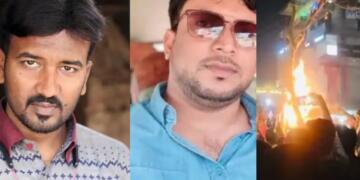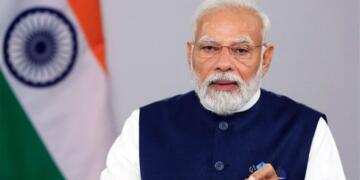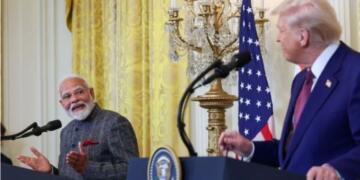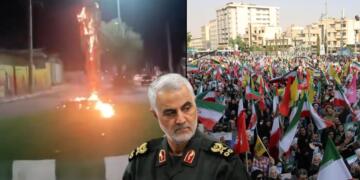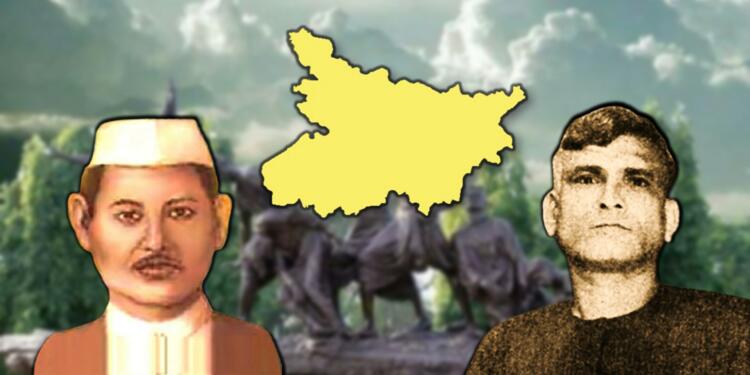Story of Baikunth Shukla and Yogendra Shukla: Have you been to Bihar before? Stop assuming. I’m not referring to the fictitious Bihari notion that has been erroneously created by corrupted media narratives, idiotic portrayals on silver screens by cinema cabals, and the vested interests of shrewd politicians trying day in and day out to just bake their bread at the expense of mocking and depriving Bihari communities.
Exploring the Untold History and Heritage of Bihar
Bihar, a land of diverse landscapes and rich cultural heritage, is a tapestry woven from its many regions. Mithila, with its mythological roots, invokes the spirit of legends and history intertwined. In contrast, the sprawling green fields and majestic mountains of Magadh offer a grand vista that speaks to the grandeur of Bihar’s natural beauty.
Further, Anga’s fertile soil and rich agricultural land embody the earthy essence of Bihar’s rural heartland to the metropolitan life rooted in Patna, and then there is Chota Nagpur, where the lush forests and abundant wildlife offer a raw and unspoiled majesty that calls to those seeking to immerse themselves in Bihar’s natural world.
All these regions, with their unique cultural and linguistic flavours, come together to form the intricate tapestry of Bihar that beats in the hearts of millions of Biharis around the world. And that is Bihar, the land of legend, natural beauty, rich cultural heritage, and what not.
Muzaffarpur: A Land of Contrasts and Emotions
Muzaffarpur, a district in north Bihar, is a place where time seems to stand still, where the echoes of the past mingle with the sounds of the present, and the vibrant city is known in modern-day India as the land of the radiant business hub and the fragrant litchis.
Muzaffarpur is a city that is steeped in historical and cultural subconsciousness of people since time and memorial of course with another name. And that’s a whole of different story altogether to discuss here.
Here, let me provide you with some interesting facts about Muzaffarpur. This city has been mentioned in Sanatani legends dating back to the time of the Ramayana and even before. Hindi classics such as “Vaishali ki Nagarvadhu” revolve around the beautiful city and its rich heritage.
Muzaffarpur, nestled in the heart of the lush Gangetic plains and on the banks of the Gandak River, has witnessed many historic events. This land has been the birthplace of great souls, the site of revolutionary movements, and the scene of many glorious victories.
From the towering figure of Dr. Rajendra Prasad, the first President of India, to the fearless freedom fighter, Khudi Ram Bose, Muzaffarpur has nurtured some of the greatest minds of the Indian struggle. It is a place where the air is thick with the spirit of revolution. Among such revolutionaries, there are two names that stand out but have been completely forgotten by the people.
And those towering freedom fighters from Muzaffarpur are Yogendra Shukla and Baikunth Shukla. The Chacha Bhatija duo of Bihar lived a life that has the capacity to leave an indelible mark on the pages of history, inspiring generations to come with their courage and conviction. But Alas! we don’t know enough about them to regard them as heroes who died serving Maa Bharti until their last breath.
Gandhi and his Challenge: the Post-Non-Cooperation Movement
It was the roaring 1920s, and Gandhi, a leader of epic proportions, had become a phenomenon that was reshaping the entire nation. His ethos had ignited a sense of patriotic fervour in the hearts of millions of Indians worldwide. Gandhi’s distinctive leadership style and ideology had never been seen before, and many believed they would never be seen again.
But, in 1923, a year after the non-cooperation movement was disbanded, the story seemed to be taking on a different hue in India and among Indians around the world. The youth of India, once so energised and full of hope under the guidance of Gandhi, found themselves lost and bewildered.
They looked to him for a path forward but were left confused and disheartened by his non-violent approach to fighting the oppressive British rule. Ideology that Gandhi was preaching seemed to be failing them in their quest for independence.
Their desperation and hopelessness started to reach a breaking point, and it was around then that a new spark of rebellion was born in the country. It was in a meeting of two young and fiery minds, Ram Prasad Bismil and Lala Hardayal founded the Hindustan Republican Association in Prayagraj, ushering in a new era of revolutionary action in the fight for India’s freedom.
Inspired by the ongoing revolutions happening worldwide, including the Russian, French, and American Revolutions, Bismil, along with Ashfaqullah Khan, Jogesh Chandra Chatterjee, Shachindra Nath Bakshi, Sachindra Nath Sanyal, and Yogendra Shukla, created the HRA.
Yogendra Shukla too joined the mission and was given Bihar’s cell to manage; while managing it, Yogendra Shukla played a pivotal role in the Kakori rebellion against the British regime. His influence grew to the point where the British government became afraid of him and moved him to Kalapani, also known as the Andaman Cellular Jail, in 1932.
The Revolutionary with Muscles of Iron and Nerves of Steel: The Story of Yogendra Shukla
Despite his extraordinary qualities, Yogendra Shukla was not able to emerge as a popular leader to represent the masses and instead remained a revolutionary of his own kind. However, fate had other plans, and even though the British authorities tried to subdue him, they were unsuccessful in controlling the tough man he was and were forced to transfer him back to Bihar in 1937.
During the Quit India Movement in 1942, the valiant Yogendra Shukla was once again imprisoned for his revolutionary activities. Yet he managed to escape from the Hazaribagh Central Jail along with several other prisoners, including the ailing Jaiprakash Narayan.
Due to JP’s poor health, Yogendra Shukla carried him on his shoulders and walked an impressive distance of 124 kilometers. That, in and of itself, demonstrates that man possessed iron muscles and steel nerves.
Forgotten Hero: Baikunth Shukla’s Story
Behold, for there is a story of two great men, born on the same day in different corners of our motherland, who went on to leave an indelible mark on the pages of our nation’s history. One of these great men was none other than Baikunth Shukla, the valiant nephew of the illustrious revolutionary Yogendra Shukla.
Born on the 15th of May in the year 1907 in the picturesque village of Jalalpur, located in the Muzaffarpur district of Bihar, Baikunth Shukla was a man of great conviction and courage. Though many may not know of his remarkable deeds, the facts speak for themselves and need no embellishment.
It is interesting to note that on the same day as Baikunth Shukla’s birth, another great son of India, the influential revolutionary Sukhdev Thapar, was also born in the city of Ludhiana, in undivided Punjab. These two men, born in different parts of our nation but united in their love for India, would go on to play a pivotal role in shaping the destiny of our nation.
The valiant man, Yogendra Shukla, whose early education was rooted in the village, his love for knowledge and learning led him to become a teacher at a lower primary school in Mathurapur. This great man had a heart full of passion and dedication for his motherland, which drove him to actively participate in the legendary Civil Disobedience Movement of 1930.
But it was his unwavering dedication to his cause that led to his incarceration in the infamous Patna Camp Jail. However, nephew Baikunth Shukla had inherited his uncle’s indomitable spirit and, with it, a cause worth fighting for.
Baikunth Shukla was a force to be reckoned with, for he had a mission to achieve and a cause to defend, and nothing was more dangerous than a man with a cause. And by his side was his stalwart wife, Radhika Devi, who was every bit as strong and resolute in her determination to fight for their cause.
In 1931, Baikunth was released from imprisonment under the Gandhi-Irwin Pact, and, in a stirring act of defiance, he and his brave wife hoisted the flag high at the historic Tilak Maidan in Muzaffarpur. Though Radhika Devi managed to evade capture, Baikunth was caught and was once again imprisoned.
Yet even his incarceration could not break the unshakable spirit of this patriotic couple. In 1932, Radhika Devi was also caught and imprisoned, but their unwavering determination and patriotic fervor burned bright.
In those tumultuous times, the air was thick with the scent of rebellion as the ruthless British imperialists plotted in secrecy and took the lives of three valiant martyrs—Bhagat Singh, Sukhdev Thapar, and Shivram Hari Rajguru—in the Lahore Central Jail.
And to our great dismay, it was revealed that four vile conspirators, members of the HSRA, were complicit in this heinous act: Jaigopal, Phanindranath Ghosh, Hansraj Vohra, and Manmohan Banerjee. But, as with other turncoats, Phanindranath Ghosh was offered a so-called “honor,” which actually was a backstabbing in the back of our nation and the HSRA, which became aching with indignation at this treachery.
The “PLAN”
Oh, how the hearts of true patriots burned with rage and sorrow as they saw the enemy of their land celebrated and feted. Yet, even in the face of such injustice, the undying spirit of the HSRA blazed on, a beacon of hope and inspiration for all who stood with their country.
In the latter half of 1932, the valiant revolutionaries of our land rallied together and posed a poignant question to the people: “Will you bear the burden of this stain, or will you cleanse it?”
Meanwhile, a meeting of the Armed Revolutionary Party Socialist Republican Army was held, and it was decided that justice must be served. The traitorous Phanindra Nath Ghosh was marked for elimination, and the noble task was entrusted to two brave warriors of our motherland, Baikunth Shukla and Chandrama Singh.
And then there’s the execution
The daring duo soon discovered that the despicable Ghosh was hiding in Bettiah, and without a moment’s hesitation, they set out on their mission. They cycled to Ghosh’s hideout in November 1932, where he was plotting with his comrade Ganesh Prasad Gupta.
Baikunth unleashed the fury of his firearm on Ghosh, taking him down with the utmost precision. And when Ganesh tried to apprehend him, Baikunth lifted him high by his throat, smashed him to ground and fired two bullets into his chest. Phanindra Nath Ghosh died on the same day, November 17, while Ganesh Prasad succumbed to his wounds on November 20.
Twist and turn that changed everything
The demise of Phanindra Nath Ghosh marked a moment of reckoning for the British government. They scurried to find the perpetrators and bring them to justice. The hunt for Baikunth Shukla was on, and a reward was declared for his capture. On January 5, 1933, Chandrama Singh was apprehended in Kanpur, but the fate of Jaigopal remained shrouded in mystery.
Baikunth, on the other hand, eluded the clutches of butcher Britishers until the British army laid siege to Sonpur’s Gandak bridge on July 6, 1933, and finally captured him, encircling him from all sides. Despite his capture, Baikunth remained unflinched, raising slogans of “Inquilab Zindabad” and “Jogendra Shukla ki Jai” at the time of his arrest.
In Muzaffarpur, Baikunth and Chandrama were prosecuted for the murder of Phanindra Nath Ghosh. Baikunth Shukla, the gallant hero, shouldered all the responsibility, saving Chandrama Singh from the gallows. On February 23, 1934, the Sessions Judge sentenced Baikunth to death, while Chandrama was acquitted of all charges.
But the story of brave Baikunth Shukla did not end there, and he didn’t go down without a fight. He appealed to the High Court of Patna against the Sessions Judge’s decision, but the verdict remained the same. On the night of May 13, 1934, Baikunth Shukla sang patriotic songs while other prisoners refrained from eating in a show of solidarity. Finally, on May 14, 1934, the valiant Baikunth Shukla was hanged in Gaya Jail, immortalised as a martyr who fought fearlessly for the cause of India’s independence.
Yogendra Shukla tried to join politics, but he did not have much success, and in 1960, a blind Yogendra Shukla left this world.
Also Read: The Guruji effect: MS Golwalkar’s role in shaping the RSS
Tribute to Heroes
Their sacrifice and determination continue to serve as a beacon of hope for those who strive for a world free from tyranny and oppression. For they knew that the path to freedom was never easy, but they walked it nonetheless, for the love of their country and the spirit of their people.
As we wander through the streets of Muzaffarpur, we cannot help but feel a sense of awe and reverence for the great souls who walked these paths before us. They may be gone, but their legacy lives on, inspiring us to be better, and to never forget the price of freedom.
Support TFI:
Support us to strengthen the ‘Right’ ideology of cultural nationalism by purchasing the best quality garments from TFI-STORE.COM



